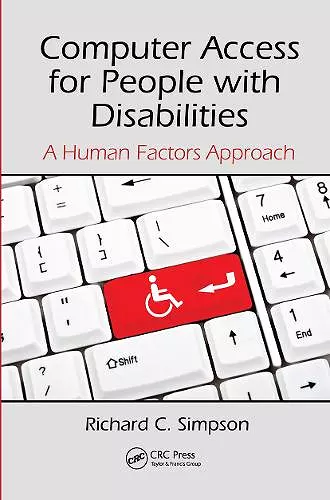Computer Access for People with Disabilities
A Human Factors Approach
Format:Hardback
Publisher:Taylor & Francis Inc
Published:11th Jan '13
Currently unavailable, our supplier has not provided us a restock date
This hardback is available in another edition too:
- Paperback£65.99(9780367380427)

Incorporating Compass Computer Access Assessment software, Computer Access for People with Disabilities: A Human Factors Approach provides the information clinicians need to know in order to provide effective alternative computer access solutions to individuals with disabilities. This book presents technology for individuals with physical, cognitive, and sensory impairments, and for older adults. The text covers text entry devices, pointing devices, switch access, automatic speech recognition, and web accessibility. The book draws on research from the fields of rehabilitation engineering, occupational therapy, and human-computer interaction (HCI) and emphasizes fundamental concepts and principles that remain true regardless of which specific operating system or product is being used.
"... makes an assumption that the reader has some experience in both applying human factors methodologies and working with populations with physical and/or cognitive disabilities. The writing is very straightforward and aims to guide practitioners to adapt their traditional methodologies to assessing the abilities of individuals with various types and degrees of impairment. The book especially excels in adapting pointing and text entry tasks to individuals with motor impairments (e.g., grasping or manipulating a mouse). Myriad design features such as key size, resolution, sensitivity, and labeling contrast are covered in depth. Even word prediction/completion software and automatic speech and voice recognition software are thoroughly detailed. The author also gives an excellent overview of signal detection theory, even going so far as to guide practitioners step by step on how to conduct these types of analyses in Microsoft Excel. ... The book delves deeply into accommodations for individuals with musculoskeletal disorders and would definitely be recommended as a primer for any professional looking to engage in computer access evaluations with that populace. Furthermore, I found the author's coverage of automatic speech recognition (ASR) to be particularly useful in my own research, as he does a thorough job of explaining the benefits and potential pitfalls of interfaces utilizing ASR. In addition, he delves into how one would go about assessing the efficacy of such interfaces when the intended user base may deal with a variety of physical and/or cognitive limitations. ... This book is an excellent read, and I recommend it to any human factors professionals looking to adapt their methodologies to work with groups or individuals with varying levels of physical and/or cognitive impairments, with the caveat that more specific works may be better for working with individuals with certain severe sensory impairments (i.e., blindness or deafness)." -Jared M. Batterman, MS, PhD Student, School of Psychology, Georgia Institute of Technology, Atlanta, USA, from Ergonomics in Design, October 2015 "What I like most about the book is its focus on the needs of the intended readership. The book offers some unique information that is not easy to acquire elsewhere potentially useful for readers outside the target users. Example, all aspects described in the section 'word prediction/completion' are of eminent interest for about two-thirds of the world population who use Short Message Service via mobile devices." -Ahmet Cakir, from Behaviour & Information Technology, 2013
ISBN: 9781466553712
Dimensions: unknown
Weight: 790g
340 pages